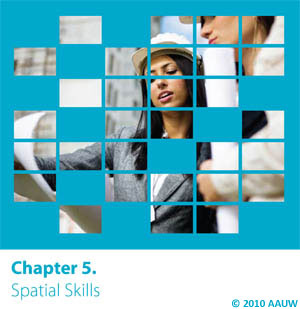


Spatial Skills Training Can Improve Retention in STEM
Engineering professor Sheryl Sorby has produced striking findings on spatial skills and retention of female engineering students. She found that among the women in her studies who initially failed the Purdue Spatial Visualization Test: Rotations (PSVT-R) and took a spatial-visualization course, 77 percent were still enrolled in or had graduated from the school of engineering. In comparison, only 48 percent of the women who initially failed the test and did not take the course were still enrolled or had graduated from the school of engineering.
 Much of Sorby's analysis is based on nonrandom samples of students since, after the first year, students opted to take the course rather than being randomly assigned. Nonetheless, Sorby's findings were consistent and compelling enough to convince the dean at Michigan Technological University to require the spatial skills course for all students who fail the PSVT:R during orientation, starting in fall 2009. Sorby is working now on understanding the impact of the course alone on retention, separate from students' motivation, since all students who fail the test are now required to take the course and are no longer self-selected.
Much of Sorby's analysis is based on nonrandom samples of students since, after the first year, students opted to take the course rather than being randomly assigned. Nonetheless, Sorby's findings were consistent and compelling enough to convince the dean at Michigan Technological University to require the spatial skills course for all students who fail the PSVT:R during orientation, starting in fall 2009. Sorby is working now on understanding the impact of the course alone on retention, separate from students' motivation, since all students who fail the test are now required to take the course and are no longer self-selected.
Sorby believes that well-developed spatial skills can help retain women in engineering and help attract more girls to science, technology, engineering, and mathematics (STEM). She sees well-developed spatial skills as important for creating confidence in one's ability to succeed in math and science courses and ultimately in a STEM career, because spatial skills are needed to interpret diagrams and drawings in math and science textbooks as early as elementary school.
In a pilot study, Sorby found that middle school girls who took a spatial-visualization course took more advanced-level math and science courses in high school than did girls who did not take the course. Sorby recommends that spatial skills training happen by middle school or earlier to make a difference in girls' choices.

Hi Laura,
Yes, I have seen some of these course materials. They involve a lot of 3-D to 2-D translations, folding exercises, isometric sketching, rotation and reflection of objects, and drawing cross-sections of solids. It does seem that playing with blocks and puzzles and construction toys helps kids' develop their spatial skills, and boys play with these types of toys more than girls. Of course, there may be a biological component to why boys play with these types of toys more than girls - but regardless of the origins, it's nice to know that anyone can develop their skills in this area if they apply themselves.
Christi
Hi Christi,
Have you seen any of the course materials? I"m really curious what kinds of activities develop spatial abilities, and why these activities come naturally to guys but not to girls, evidently. Car repair?? Bungee jumping??
cheers,
Laura















